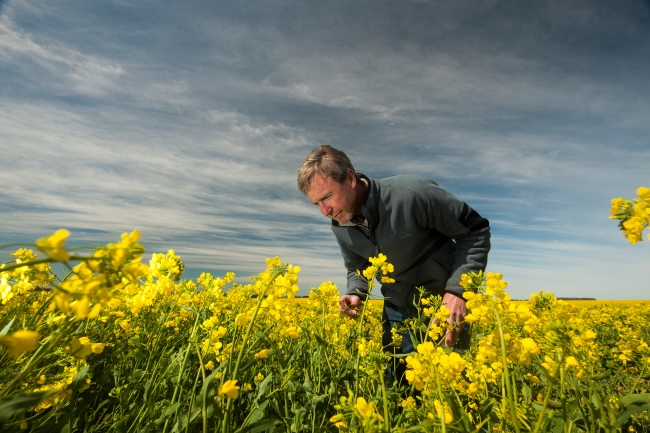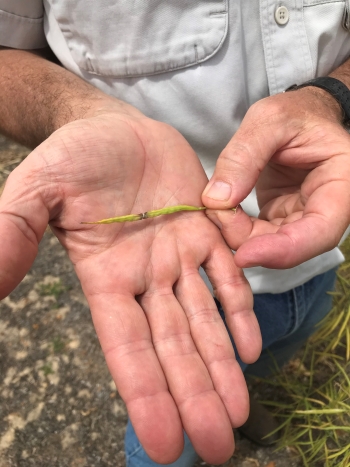Paddock Practices: EP growers need a plan to preserve SDHI for blackleg control in canola
Date: 02 Sep 2021

Growers in South Australia’s Eyre Peninsula (EP) are being encouraged to consider their 2022 season fungicide management strategy for blackleg in canola ahead of placing next year’s seed orders.
Without careful planning there is growing concern from industry experts about an increased fungicide resistance risk in the EP, particularly to succinate dehydrogenase (SDHI, Group 7) fungicides.
Marcroft Grains Pathology principal Steve Marcroft, who is co-ordinator of the Grains Research and Development Corporation’s (GRDC) National Canola Pathology Program investment, said the EP had the highest canola growing intensity of any region in Australia, which put increased pressure on fungicides.
Dr Marcroft said surveys on the EP have detected reduced sensitivity to demethylase inhibitor (DMI, Group 3) fungicides such as Impact® in-Furrow, Jockey® Stayer® and Prosaro® 420 SC. No field failures have yet been reported so DMIs can still be used, but this is a warning that sole use of the same mode of action (MOA) may lead to future failures.
Therefore, he said it was critical growers considered varietal resistance and seed treatments options to avoid resistance development to newer chemistry, such as SDHIs (Saltro®, ILeVO®, Aviator® Xpro®, Miravis®).
“Where growers and advisers are considering the use of SDHI (Saltro®, ILeVO®) seed dressings, followed with a SDHI fungicide (Miravis®, Aviator® Xpro®) at the four-to-six leaf stage, they should be aware of the high risk of blackleg rapidly becoming resistant to what are currently extremely effective fungicides,” Dr Marcroft said.
His simple message.
- Only use fungicides if there is a high priority of yield return. Therefore, grow a cultivar with a high blackleg rating and scout for disease before making a decision to apply a foliar fungicide.
- Do not use two applications of the same mode of action (MOA) for crown canker control (in-furrow, seed treatment, four-to-eight leaf foliar).
- If you use SDHI for multiple applications for crown control you may not have the technology for very long.
- It is okay to use the same mode of action for crown control (seedling) and Upper Canopy Infection (UCI flowering growth stage).
“EP canola growers have some very effective tools to control blackleg and they need to consider their options when it comes to varietal selection and seed treatments,” Dr Marcroft said.
“Simply replacing DMIs with repeated or high frequency use of SDHIs will encourage new resistant strains of the pathogen. Although SDHIs have an improved efficacy against blackleg they are also more likely to be overcome by the pathogen.”
He said the main issue in the EP was growers had limited rotation options, so they grew wheat and canola.
“In regions like the EP fungicides provide an excellent tool to prevent yield losses from diseases like blackleg, however risk of fungicide resistance developing is extremely high without them being used in conjunction with integrated management practices,” he said.
“But varietal choices, integrated disease management strategies and responsible use of fungicides can help minimise the risk of fungicide resistance developing.”
Best practice planning measures

A recent AFREN case study also examined blackleg in canola in the lower Eyre Peninsula. Dr Marcroft said growers and agronomists could protect the long-term effectiveness of their new fungicides by strategically using the fungicides when they were most likely to result in an economic yield gain.
- Selection of cultivars with appropriate resistance and careful monitoring of each season’s blackleg risk will help reduce the need to apply fungicides. Planting the most resistant cultivar is generally best although rotating cultivars will limit the risk of blackleg overcoming the main genetic resistance.
- Seed treatments and flutriafol on fertiliser is less likely to be needed when seed is sown early enabling the seedlings to develop before any major winter spore showers occur. Later sowings should use a SDHI treatment in preference to a DMI.
- Seed treatment and fertiliser fungicide in combination should not both be needed unless a susceptible cultivar is being planted.
- Ideally, growers will only need to resort to chemical controls when disease pressure demands it. For example, if severe blackleg lesions are found on plants before the fifth leaf stage a foliar fungicide from a different MoA Group to the seed treatment can be applied.
- For Upper Canopy Infection fungicide applications, crops that commence flowering early (July to early August) will have a greater probability of yield loss compared to crops that flower from mid-August onwards.
- Finally, growers can use the BlacklegCM app to model their potential costs and yield losses under different fungicide scenarios. If a foliar fungicide is applied, leaving an untreated strip will provide a valuable comparison to inform fungicide strategies for future seasons.
How to reduce selection pressure
The Australian Fungicide Resistance Extension Network, which is supported by the GRDC, provides the following information to growers and advisers on understanding fungicide resistance in canola:
- It is essential to rotate and mix fungicide actives and MOA groups to avoid consecutive applications of the same chemistry, including between seasons if only one application is needed within a season.
- Remember that seed treatments and in-furrow fungicides also count as a fungicide application, so a foliar application from the same fungicide group in the same season should be avoided.

To assist growers and advisers reduce the fungicide risk AFREN have also produced a southern region webinar featuring Dr Marcroft, along with industry experts Tara Garrard from South Australia Research and Development Institute (SARDI)* and Nick Poole from Field Applied Research (FAR) Australia this webinar discusses seasonal conditions and control options.
Dr Marcroft offers the following advice to reduce selection pressure:
- Seed treatment/fertilised applied and four-to-eight leaf both control crown canker. Therefore, rotate MOA.
- Upper canopy infection (UCI) is considered a separate infection. Therefore, growers can use the same fungicide as the seedling foliar.
- If you use a Group 7 as a seed treatment don’t use a Group 7 at four-to-eight leaf (for example, use a Group 3 or 11+3).
- If you use a Group 7 as a seed treatment you can use Group 7 at 30 per cent bloom.
- You have Groups 3, 7 and 11+3 that can be used at four-to-eight leaf and 30 per cent bloom.
For more information to help support your in-paddock decision making this season go to the AFREN website.
Resources
Was this page helpful?
YOUR FEEDBACK
